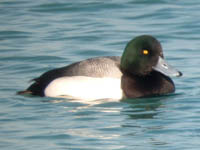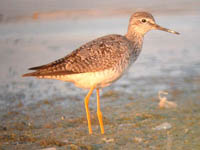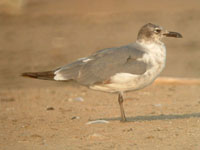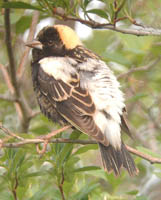Waterfowl

Greater Scaup
The north-south axis of Lake Michigan forms a natural corridor for migrating waterfowl. During March and again in October and November, almost all of the regularly occurring ducks in the Chicago area can be seen moving past Montrose Point or resting on the lake or inside the harbor. The best place to look for waterfowl at Montrose is from the Fishing Pier, though if waves are crashing over the pier you’ll be taking your life into your hands if you venture onto it.
Surf, Black, and White-winged Scoters are regular in small numbers in late fall, and White-winged Scoters are regular in late winter and early spring, sometimes in large numbers.
Though never common, Harlequin Ducks have been found close to shore or even inside the Harbor during the colder months of the year.
Hundreds or even thousands of Red-breasted Mergansers gather in the waters off Montrose Point in April to feed on smelt, a small schooling fish that moves into the inshore waters of Lake Michigan to reproduce.
Though less common now than in previous years, a few Long-tailed Ducks can still be seen in late fall, winter, and early spring. Occasionally one will show up close to shore or even inside Montrose Harbor.
Most geese, with the exception of Canada, are rare at Montrose, though Cackling and Snow Geese are seen occasionally, especially in late fall, and Greater White-fronted Geese are sometimes seen in early spring. Ross’s Geese have been recorded a few times.
Tundra Swans are sometimes seen in November and December, mostly flying east over the Point.
Shorebirds
Montrose Beach is the best beach in Chicago to see migrant shorebirds. To date, 39 species have been recorded there; of these about 22 are annual. Unfortunately, Montrose Beach is also a popular swimming and dog walking beach, so most shorebirds don’t bother stopping or if they do stop they don’t stay long. However, if there is green “gunk” on the beach during migration there will usually be shorebirds feeding in the stuff. This gunk is just accumulated algae, leaves, and other organic debris (and some inorganic too!)

Lesser Yellowlegs
Piping Plovers like the wide sandy beach and are about as likely in spring as fall, from late April to mid-May and again from mid-July to about Labor Day.
American Golden-Plovers are seen every fall in September, usually flying over the beach. They are occasionally seen in spring as well.
Black-bellied Plovers are seen in the spring and fall and are more likely to spend time on the beach than the American-Golden Plover.
Willets are seen every spring, usually in late April and early May, and again in late summer, starting in early July and running through August. Large flocks of 20 or more birds are not uncommon.
Baird’s Sandpipers are regular in late summer and early fall, beginning in mid-August. An even more uncommon species, the Buff-breasted Sandpiper is seen every fall in small numbers. Though most often seen as flybys, one will sometimes land on the beach, where they can be very tame and approachable.
Whimbrels are recorded every year, with the third week in May and the period around Labor Day being the best times to see this elegant wader. Unlike other shorebirds, Whimbrels can sometimes be seen away from the beach, walking on the grass or rocks, and like the Buff-breasted can be very tame.
Red Knots have been recorded a number of times over the years, mostly juveniles in August and September.
During the late 1970s and early 1980s, Red Phalaropes were almost regular at Montrose in November. They were most often seen at the base of the fishhook pier, spinning and feeding in the mucky water near the beach. Although one hasn’t been seen at Montrose in a few years, this species should still be looked for in November and December.
American Woodcocks are often flushed from the hedges and underbrush in March and October. They can also be seen flying in off of Lake Michigan after a night of migration.
Finally, Wilson’s Snipes can be found in the Meadow and Dunes in April and September and October; like the Woodcock they usually make their presence known only after being flushed.
Other Waterbirds

Laughing Gull
The open waters of Lake Michigan, the beach, the boat harbor, and even the small pond at the north end of Waveland Golf Course can be very productive for a variety of waterbirds.
In April and again in November, Common Loons can be seen flying past the Point, especially during strong onshore winds. Red-throated Loons are also seen occasionally, usually in late fall and early spring.
Among the grebes, Horned and Pied-billed are regular visitors in spring and fall, and can sometimes be found close to shore or even inside Montrose Harbor. Red-necked, Eared, and Western Grebes have also been recorded on several occasions.
Large flights of Double-crested Cormorants are regular at Montrose, particularly in April and September. They also occur inside Montrose Harbor in small numbers and a colony has taken up residence on the water crib offshore from Montrose.
Though lacking a marsh or large wetland, all of the herons recorded in Illinois have been seen at Montrose. Black-crowned Night-Herons are often seen flying up and down the lakefront during summer or roosting in the harbor or golf course pond. The hedges and open areas at Montrose can be very good for Least and American Bitterns. The Least is invariably found in May, and the American can be found in April and May and again in September and October.
Incredibly, all of the rails recorded in Illinois have been found at Montrose. Sora and Virginia Rail are seen every year and King Rails have been found on several occasions. Rails find the grass and underbrush in the Meadow especially attractive. The wetlands in the Dunes can also be productive.
Not surprisingly, 19 species of gulls have been seen at Montrose. Laughing Gulls are regular, especially in the spring, and Franklin’s Gulls are regular in the fall. Occasionally, large numbers of Franklin’s are seen along the lakefront in late October and November when there is a strong west wind. Iceland, Great Black-backed, and Glaucous Gulls can be found in late fall and winter. Though less common in recent years, Lesser Black-backed Gulls can be found at almost any time of the year.
Of the terns, Caspian is regular from April to September, with the largest numbers occurring in late April and early May. In May and again in August and September, Common and Forster’s Terns can be seen migrating along the lakefront or even roosting on the beach with gulls. Though much rarer now than in past years Black Terns are sometimes seen, particularly in late summer.
Birds of Prey

Merlin
Unfortunately, Montrose Point isn’t a great place to see birds of prey, though there are exceptions.
When Snowy Owls are invading, Montrose is one of the more reliable places in the Chicago area to see this spectacular Arctic predator. Snowies are especially fond of the Fishhook Pier but can also be found on top of the beach house or even perched on a light pole.
Short-eared Owls are often flushed from the Dunes in October and November on days with strong westerly winds; as many as 4 or 5 have been seen in the air at the same time. Long-eared Owls are sometimes found roosting in the trees or hedges during migration.
The bushes and shrubs at Montrose provide cover for Northern Saw-whet Owls, which are most often seen in October and November, especially following the passage of a cold front.
Peregrine Falcons can be seen at any time of the year hunting over the Point or even out over the lake, usually in pursuit of tardy migrating passerines. They have also been seen taking bats. The Peregrines seen at Montrose are invariably introduced birds or the progeny of introduced birds.
Merlins are regular visitors in April and September and October. These small falcons seem to delight in terrorizing the sparrows and other passerines that gather at Montrose in the fall.
Finally, Ospreys and Northern Harriers can be seen during migration, with September being the best month for the former and October and November the best months for the latter.
Passerines and Other Landbirds
Spring
Each spring thousands of warblers, thrushes, sparrows and other landbirds use Montrose Point for feeding and resting. Spring migration begins in March as the earliest and hardiest songbirds begin to return. The peak of spring migration for passerines at Montrose is in May. A warm front and accompanying south winds will bring hordes of hungry migrants seeking food and shelter. Occasionally a phenomenon known as a fallout occurs. This happens when a cold front hits a wave of migrants during the night and forces them to the nearest land. Because of the cold temperatures (and often wind and rain), many otherwise arboreal birds are forced to the ground to find food and shelter.

Bobolink
Eastern Whip-poor-wills are sometimes flushed from the shrubs and bushes in late April and early May; occasionally one will even be found roosting in a tree or on the ground.
The open nature of Montrose makes it an excellent place to study flycatchers, particularly the Empidonax. Least, Willow, Alder, and Yellow-bellied are all regular in May and early June. Olive-sided Flycatchers are seen most springs, usually perched on a bare branch or snag.
Of the vireos, Red-eyed, Warbling, Philadelphia, Blue-headed, and Yellow-throated occur every spring. White-eyed and Bell’s Vireos are also occasionally seen.
The Meadow and the Dunes are both excellent places to find Marsh and Sedge Wrens.
All of the Catharus thrushes and Wood Thrush are regular; large numbers of these thrushes can often be heard migrating overhead at night.
American Pipits are regular at Montrose with two peaks, one in late March and early April the other in early May.
Scarlet Tanagers begin to arrive in late April; after a night of south winds in May, small flocks of these neotropical migrants can be found adorning the tops of trees. Summer Tanagers are rare but regular visitors, usually in May.
Montrose is an excellent place to see warblers. Again, the scattered trees and open nature of the Point make for relatively easy warblering, though this fact won’t prevent warbler neck. To date, 38 species of warblers have been recorded, and of these 29 are regular in spring. Montrose is especially good for Mourning and Connecticut Warblers, which find the shrubs and hedges particularly attractive.
Without a doubt, Montrose is the best place in Illinois and probably the best place in the entire Midwest for sparrows. Of the more uncommon species, Clay-colored is regular in May and Harris’s Sparrow is seen most springs, as are Lark Sparrows. Montrose’s main claim to sparrow fame, however, are the furtive, grass-loving species. LeConte’s, Henslow’s, Nelson’s, and Grasshopper are regular visitors, the LeConte’s, Henslow’s, and Grasshopper in mid and late April, the Nelson’s in late May. The Dunes and Meadow are by far the best places to see these skulkers.
Baltimore Orioles can be abundant in May and Orchard Orioles are regular in small numbers in May. Both species show a predilection for the newly-opened flowers of the Norway Maple.
Fall
The fall migration of passerines is also impressive, though more drawn out and less frenetic than in spring. Many birds found commonly during the spring are uncommon or less noticeable in the fall, such as the colorful tanagers and orioles. The potential for rarities and vagrants is greater in the fall, however, and several birds are actually more frequent.
Although large flights of Common Nighthawks seem to be a thing of the past, numbers can still be seen moving by the Point in August and early September.
When Northern Shrikes are around, the Meadow and other open areas are excellent places to see this predatory songbird.
Until fairly recently, Montrose was a major staging area for southbound Purple Martins in August and September. Sadly, only a handful are seen anymore, and most of these are the local nesting birds.
Sparrows are better in fall than in spring at Montrose; on one memorable day in October of 2000, an incredible 17 species were seen by several observers, one of the highest totals in the United States. Harris’s Sparrow is recorded every October or November, and Nelson’s and LeConte’s Sparrows also occur regularly. In recent years, Nelson’s have been found with regularity in the Dune vegetation in September and October.
Lapland Longspurs and Snow buntings like the more open areas of the Point, especially the Dunes and Montrose Beach. Laps start to appear in mid-September and Snow Buntings begin to show up in mid-October.
Other Critters

Monarch
In early fall, numbers of migrating Monarch butterflies use the trees and shrubs to rest before continuing south. For a few days in September of 2003, there were literally thousands of these showy black and orange butterflies at Montrose. Monarchs can also be seen flying over the Point, somewhat akin to migrating raptors.
Several different species of bats are regular during late summer and early fall. The best time to see these volant mammals is in the early morning as they come in off of Lake Michigan after a night of migration. Unfortunately for the bats, the local Peregrine Falcons prefer to hunt them over birds.
Terrestrial mammals observed at Montrose include White-tailed Deer, Raccoon, Red Fox, Coyote, North American Beaver, and Virginia Opossum.
Finally, a number of different fish have been recorded, including Freshwater Drum, Smallmouth Bass, Burbot, Longnose Gar, Northern Pike, and several introduced salmonids. Many of these can be seen in Montrose Harbor.
For a small park in the middle of a large urban area, the diversity of wildlife seen at Montrose is truly impressive.
